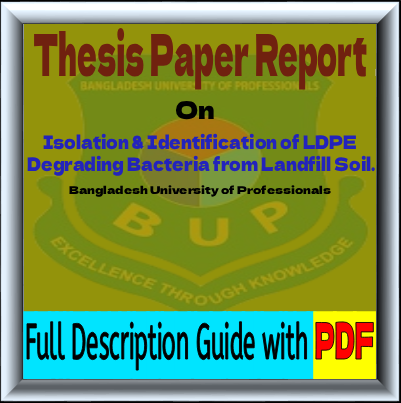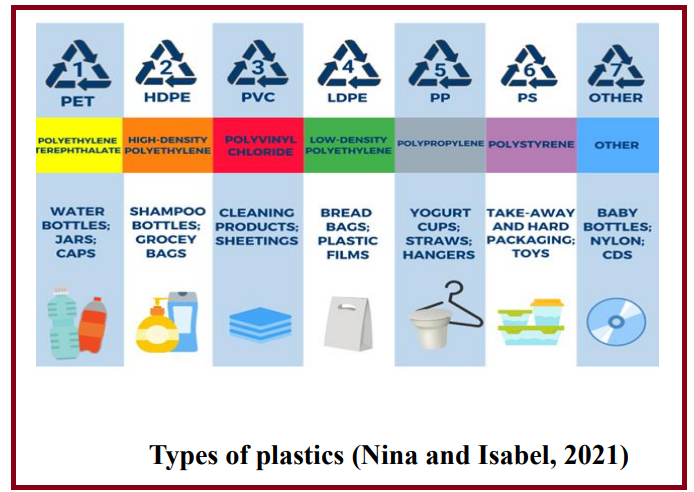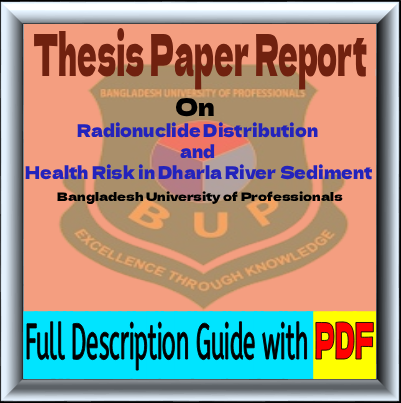
The aim of this study was to isolate the bacteria from the soil of landfill and to evaluate microbial degradation of the sheet of low-density polythene (LDPE). To find the microbes that can degrade polythene, samples were collected from Amin bazar landfill soil, Dhaka.
Screening of polythene degrading bacteria was performed by analyzing the growth in Low Density Polyethylene (LDPE) powder. Eight potential bacterial isolates were obtained using mineral salt media containing LDPE powder as sole carbon source. LDPE poly poses environmental objections due to its non-biodegradable nature.
Generally, The Gram staining test revealed all the isolates were Gram positive. The dry cell weight (g/100 L) was measured at 0.1% concentrations of LDPE powder; the biomass was increased for all the bacterial isolates. Isolates 2 and 7 had the highest cell weight values of 0.9 g and 0.8 g, respectively. The weight loss in LDPE sheet by isolate strain 3 and strain 2 was 41% and 33%, respectively. Thus, the potential isolates could be used as LDPE degrading bacteria.
Background of the Study
The term plastic is obtained from Greek word “plastikos‟ which means “capable of being shaped or molded”. Natural and inanimate raw materials such as carbon, silicon, hydrogen, nitrogen oxygen and chloride are used for the produce of plastic and are in use today. Plasticity is the property of any material by which the material can irreversibly deform without breaking. A polymer is a super molecule composed of repeating structural components connected by covalent bonds. Examples of polymers include plastics, starch, and proteins.
In short, in 1988, the Society of the Plastics Industry establish the Resin Identification Code (RIC) system which split plastic resins into 7 different classifications such as- PET, HDPE, LDPE, PP, PS, PVC, and others. The first low density polyethylene (LDPE) was design using the high-pressure polymerization of ethylene.
| Report Title : | Isolation & Identification of LDPE-Degrading Bacteria from Landfill Soil. |
| University Name : | Bangladesh University of Professionals |
| Submitted To : | Dr. Tabassum Mumtaz |
| Submitted By : | Sun Jarin Juthi |
| Total Page : | 91 |
low density is due to the existence of a modest degree of branching in the chain (on around 2% of the carbon atoms). Low-density polyethylene presents a outshanding environmental challenge due to its non-biodegradable nature and universal use. LDPE products, such as plastic bags, transportation, food, clothes, medicine, recreation, fishing nets, packaging, and the food industry contribute significantly to plastic pollution.

The aim of this research was to study the biodegradation of low-density polyethylene using various techniques in vitro by selected and potent microorganism isolated from municipal solid waste.
Problem Statement
This enormous amount of plastic is still buoyant in the water and may be seen on top of and underneath the earth. It’s become a important issue because of the harm it does to people wildlife and their habitats. There are a different of ways in which plastic trash harms ecosystems. Because plastics stay so long in the ecosystem, it pollutes, takes up space, and poisons habitats.
Moreover, All the trash that did not get reclaim became a hazard for marine life. The ocean is messy with trash. When marine organisms ingest it, it’s a happy accident. This plastic has a negative impact on their health. Micro plastics, for instance, have been detected in the organs of marine mammals, including the liver, the stomach, and the kidneys.
Outline of the Report
Introduction part
Background of the study, Problem statement, Rationale of the study, Research questions, Objectives of the study, Research gap, Limitations of the study.
Literature review Part:
Plastics, Types of plastics, Brief history of LDPE, Environmental contamination by LDPE, Soil contamination by LDPE, Water pollution by LDPE, Air pollution by LDPE, Effects on public health, Biodegradation of LDPE, Biodegradation by bacteria, Biodegradation by fungi, Mechanism of microbial degradation.
Methodology Part:
Materials, Area of Study/Sampling site, Sample collection, Methods, Instruments, Sterilization of glassware and media, Mineral media preparation, LDPE powder preparation, Isolation and maintenance of microbes, Stock solution preparation, Enumeration by serial dilution technique,
Plate preparation and inoculation, Isolation of bacterial colony, Pure culture preparation, Characterization of bacteria, Colony morphology, Gram staining, Biochemical tests, Indole production test, Methyl Red (MR) test, Voges- Proskauer test, Citrate utilization test, Catalase test, Oxidase test, Utilization of LDPE as sole carbon source in shake flask, Optical density measurement,
Dry cell weight measurement, LDPE degradation experiment using LDPE sheet in MSM broth, Polyethylene sample preparation, Incubation of bacteria with treated polyethylene.
Data analysis Part:
Measurement of optical density, Determination of cell weight, Determination of weight loss.
Result and discussion Part:
Isolation of LDPE degrading microbes, Determination of morphological and biochemical characteristics, Determination of LDPE degradation efficacy of the isolated bacterial strains, Weight loss of LDPE by isolated strain, Major findings, Discussion.
Research Objectives
Broad objective
To Isolate and characterize the low-density polyethylene (LDPE) degrading soil bacteria from plastic contaminated soil.
Specific objectives
- To isolate the potential bacteria which can degrade LDPE?
- To determine the morphological and biochemical characteristics of potential bacteria.
- To determine plastic degradation efficacy of soil bacteria, present in plastic contaminated site.
- To determine the weight loss of LDPE sheet by potential isolated bacterial strains.
Research questions
- Is the soil microbe potential to degrade the plastic substances in plastic contaminated soil in Bangladesh?
- Which plastic degrader species are abundant in such contaminated soil?
- Which are the most efficient plastic degraders among all the microorganisms in the collected samples?
Key Analytical Highlights
LDPE’s environmental importance
- LDPE (LDPE) is widely used in daily life (plastic bags, packaging, nets, and bottles).
- Its inorganic decaying nature has made it one of the most horrific contaminants for soil and water.
Sampling Site – Amin Bazar Landfill, Dhaka
- Amin market samples have been collected from the landfill, where municipal waste and plastic pollution exist.
- This place is chosen because high microbial activity exists here on plastic-polluted soil.
Plastic-credited bacteria isolation
- Six bacterial strains have been successfully disconnected on mineral salts media, where LDPE powder was the only carbon source.
- All Isolates were village-positive bacteria, capable of adapting to the LDP environment.
Biochemical and Morphological Test
- Bacteria are tested through gram stneing and various biochemical tests (Catalase, Oxidase, MR-VP, Citrate, Indole Tests).
- The results show that multiple isolate LDPE is capable of breaking the polymer.
Degradation effectiveness
- The LDP sheet degree has been tested through weight loss after bacterial activity.
- Strain 3 has a maximum of 41% degrees, followed by strain 2 (33%).
- Other strains have shown 25-25% of the degree.
Growth Performance and Biomass
- Dry Cell Weight Analysis has proven that bacteria have increased well in the LDP media.
- Strain 2 (0.9 g/100 liters) and strain 7 (0.8 g/100 liters) produce the most biomass.
Plastic waste management is the possibility of microbial
- Studies have shown that soil microbes can naturally make plastic degrees, which are helpful in reducing long -term pollution.
- In the future, these bacteria can be used in the Bioremediation Project and Waste Treatment Plant.
Contribute to scientific research
- This study has added new information from Bangladesh, which will help in the global effort of finding an environmentally friendly method of plastic degrees.
- Besides, it has created new opportunities for the expansion of research for biotechnology, microbiology and environment engineering students.
Conclusion
In this study chosen bacterial strains display amazing ability in digesting polyethylene, providing a permanent solution to environmental harm. This study can help decreasing the environmental impact of polyethylene agglomerate, protecting ecosystems, and paving the way for a cleaner greener future by developing interdisciplinary cooperation and investing in breakthrough biotechnological solute.
Frequently asked Questions (FAQS)
- Question 01: Why does LDPE not naturally decay easily?
- Answer: The LDPE’s polymer structure is extremely stable and branching, which prevents microbial attacks. As a result, it remains intact in the environment for decades.
- Question 02: Why Amin Bazar has been collected from the soil of the landfill?
- Answer: This landfill contains a large amount of plastic waste, which is an ideal place to find microbes adapted in a plastic-polluted environment.
- Question 03: Which bacteria proved the most effective in the LDPE degree?
- Answer: Strain 2 and Strain 3 showed the highest effectiveness, where the maximum weight loss of 5% was found in the laboratory examination.
- Question 04: How does this study help reduce plastic pollution?
- Answer: This study provides a biological alternative solution by identifying bacteria capable of LDPE degree, which can be effective in reducing plastic waste management and environmental pollution.
- Question 05: How can students and researchers benefit from this study?
- Answer: It is an important reference for environmental microbiology, biotechnology and waste management studies and research. Besides, it gives a realistic idea about the biological solution of plastic pollution.











